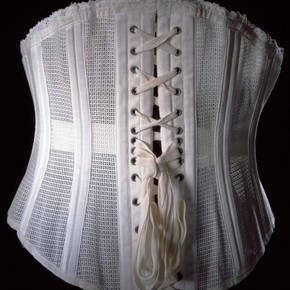The Victorian Era, named after Queen Victoria, was the period between 1837 and 1901 (19th century). Looking back at the Elizabeth era, and comparing women's make up, hair and clothing on the Victorian, I would say that a lot, but at the same time it hadn't changed much.


Portrait of Queen Victoria (study)
oil on canvas, 1838
artist: Thomas Sully
Metropolitan Museum of Art
(source: http://commons.wikimedia.org/wiki/File:Sully_-_Portrait_of_Queen_Victoria.jpg)
Make up and Complexion
The biggest difference between the two eras is that Queen Victoria was strictly against make up. The Victorian Era was a time dominated by a strict moral code, modesty and religious values, therefore, make up was considered immoral. Only acctresses and prostitutes openly wore strong make up, while other ladies used very little, barely noticable make up products in soft, natural tones.
Pale complexion (a sign of nobility and wealth) was still in fashion as well as emphasizing and drawing on veins to make the skin look more translucent. To lighten the skin, women used Zinc Oxide, a white mineral powder, which was a lot safer than the mixtures used in the past, but had the same effect on the skin. They drank vinegar and used parasols when going outside to protect their skin from the sun. Also, some women would emphasize their dark circles to get almost a sickly look, and they would apply red rouge on lips and cheeks. To prevent shine they would use powders.
Eyeshadows they used were made out of lead and antimony sulfide and lipsticks out of mercuric sulfide. Beet juice was applyed as blusher, but very sparingly so it wouldn't be noticable.
Also, they believed the 'science' of using a person's head to determine their personality and inteligence. Moleoscopy is a subgenre of the practice, which claims to identify that based on the mole placement. For example if someone had a mole on the right side of their forhead, they were considered extremly intelligent and competent.
Eyeshadows they used were made out of lead and antimony sulfide and lipsticks out of mercuric sulfide. Beet juice was applyed as blusher, but very sparingly so it wouldn't be noticable.
Also, they believed the 'science' of using a person's head to determine their personality and inteligence. Moleoscopy is a subgenre of the practice, which claims to identify that based on the mole placement. For example if someone had a mole on the right side of their forhead, they were considered extremly intelligent and competent.
DIY Skincare
Women would make their own skincare products by mixing natural ingredients found in the kitchen. They mosty made tonics out of water and scents of lilies, roses or violets and creams with waxes, almond oil and scents. To cover up scars or acne they used mostly pastes, but also powders and paints to smooth their complexions. These products were sold at the local pharmacy or through doctors. The very wealthy could afford to even order the products from abroad, but the poor mostly used home-made products.
Hair
As well as in the Elizabethan era, to women (but also men), hair was everything.
Women would usually pull their hair back in buns and chignons, and a few curls were let loose at the back and sides to emhasize their faces. They would only cut their hair when they were ill and false hair was applyed for the hairstyles to look bigger and fuller and decorate it with combs and clips. Oils were used to give the hairstyles a sleek apperance.
Men started wearing much shorter hair in this era but beards and moustaches were still in style.
Style and Clothing
In the 19th century it was all about the hourglass shape. Having a small waistline and wide hips was considered sexy.
To achieve 12-inch waistline was every womans dream. They would wear corsets and tighten them so hard to the point they could hardly breathe or sit down. Some women would even break their ribs by doing this. Girls would start wearing them at a young age, before puberty and they were called reform corsets. The most expensive corsets were made out of satin and whalebone.

Corset, Artex
1888-1895
Museum no. T.234-1968
Museum no. T.234-1968
(source: http://www.vam.ac.uk/content/articles/c/corsets-and-bustles-1880-1890-from-over-structured-opulence-to-the-healthy-corset/)
To make their hips look bigger and wider they would wear layers of petticoats, hoops and bustles. Bustles came in all shapes and sizes. Some were mostly made out of steel and some had big 'cushions', often stuffed with horsehair.
Skirts were wide and long, reaching the floor. In 1856 the cage crinoline came back in fashion, but bigger and wider than before and had huge round-shaped hoops. Jacked bodice was also popular and it usually covered the hips. Daytime clothes covered their cleavages and arms, but in the evening the necklines were off-the-shoulder.
http://beautifulwithbrains.com/2010/08/06/beauty-in-the-victorian-age/
http://vintagefashionguild.org/lingerie-guide/corsets-early-19th-century-edwardian/
http://trulyvictorian.com/history/1855.html
http://www.vam.ac.uk/content/articles/c/corsets-and-bustles-1880-1890-from-over-structured-opulence-to-the-healthy-corset/
http://www.popsugar.com/beauty/photo-gallery/18372937/image/18373738/Victorian-Era
reference found on Jan 20/21 2015
Nema komentara:
Objavi komentar